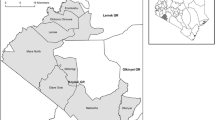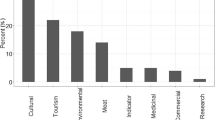
Overview
- First to look at community-based conservation efforts in eastern Africa
- Cross-border comparison aids in determining proven methods that work and don't work
- Based on three decades of the community conservation effort and reported by an international group of contributors
- Includes supplementary material: sn.pub/extras
Part of the book series: Studies in Human Ecology and Adaptation (STHE, volume 5)
Access this book
Tax calculation will be finalised at checkout
Other ways to access
About this book
The area of eastern Africa, which includes Tanzania and Kenya, is known for its savannas, wildlife and tribal peoples. Alongside these iconic images lie concerns about environmental degradation, declining wildlife populations, and about worsening poverty of pastoral peoples. East Africa presents in microcosm the paradox so widely seen across sub Saharan Africa, where the world’s poorest and most vulnerable populations live alongside some of the world’s most outstanding biodiversity resources.
Over the last decade or so, community conservation has emerged as a way out of poverty and environmental problems for these rural populations, focusing on the sustainable use of wildlife to generate income that could underpin equally sustainable development. Given the enduring interest in East African wildlife, and the very large tourist income it generates, these communities and ecosystems seem a natural case for green development based on community conservation.
This volume is focused on the livelihoods of the Maasai in two different countries - Kenya and Tanzania. This cross-border comparative analysis looks at what people do, why they choose to do it, with what success and with what implications for wildlife. The comparative approach makes it possible to unpack the interaction of conservation and development, to identify the main drivers of livelihoods change and the main outcomes of wildlife conservation or other land use policies, while controlling for confounding factors in these semi-arid and perennially variable systems. This synthesis draws out lessons about the successes and failures of community conservation-based approach to development in Maasailand under different national political and economic contexts and different local social and historical particularities.
Similar content being viewed by others
Keywords
Table of contents (10 chapters)
-
Front Matter
-
Family Portraits – Amboseli
-
Family Portraits – Longido
-
Family Portraits – Tarangire
-
Back Matter
Reviews
Editors and Affiliations
Accessibility Information
Bibliographic Information
Book Title: Staying Maasai?
Book Subtitle: Livelihoods, Conservation and Development in East African Rangelands
Editors: Katherine Homewood, Patti Kristjanson, Pippa Chenevix Trench
Series Title: Studies in Human Ecology and Adaptation
DOI: https://doi.org/10.1007/978-0-387-87492-0
Publisher: Springer New York, NY
eBook Packages: Earth and Environmental Science, Earth and Environmental Science (R0)
Copyright Information: Springer-Verlag New York 2009
Hardcover ISBN: 978-0-387-87491-3Published: 11 February 2009
Softcover ISBN: 978-1-4419-2766-8Published: 23 November 2010
eBook ISBN: 978-0-387-87492-0Published: 08 February 2009
Series ISSN: 1574-0501
Edition Number: 1
Number of Pages: XVI, 418
Topics: Nature Conservation, Anthropology, Landscape Ecology, Demography



